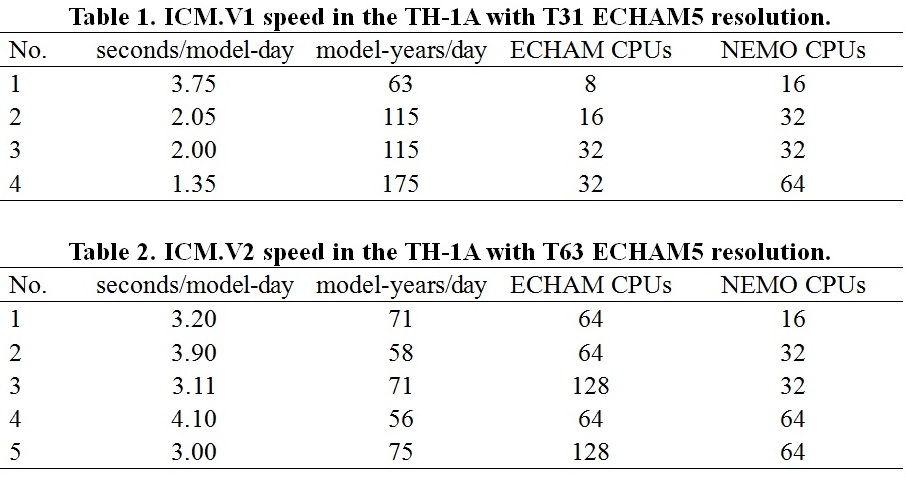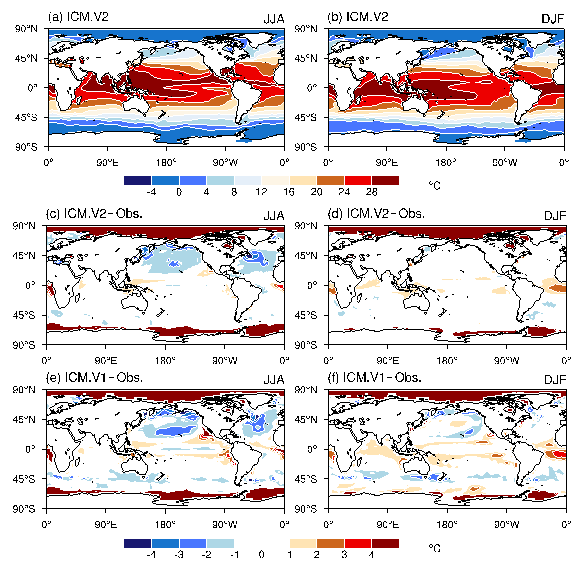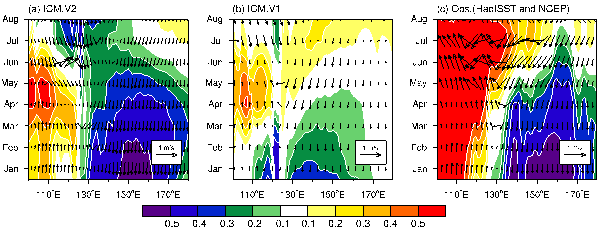State Key Laboratory of Numerical Modeling for Atmospheric Sciences and
Geophysical Fluid Dynamics (LASG)
Institute of Atmospheric Physics, Chinese Academy of Sciences

Vol. 2/No.2 April 2017
[Model development, algorithm, and evaluation] The computational performance and the improved simulation of East Asian–western North Pacific climate by the ICM Version 2
The version 2 of the Integrated Climate Model (ICM) by the Center for Monsoon System Research at the InstituteofAtmospheric Physics(CMSR/IAP) is developed (the first version is released in May 2014). There are two stages in developing the ICM.V2. The first stage is form May 2014 to Oct 2014 by Wang Pengfei and Ding Zhaoming to develop the framework and coupler technically suitable for T63 and even higher ECHAM resolutions. The main update of the ICM.V2 relative to ICM.V1 is the improvement of the horizontal resolution of the atmospheric model from T31 spectral resolution (3.75° × 3.75°) to T63 (1.875° × 1.875°). The second stage is from Oct 2014 to Dec 2016 by Yan Bangliang, Huang Ping and Wang Lei et,al. to turning the NEMO and coupled model simulation performance.
Having dealt with many issues to improve the ICM’s simulation speed, we now demonstrate its computational performance in TH-1A. Table 1 depicts that ICM.V1 runs 115 model years per day by applying 16 ECHAM processes and 32 NEMO processes. In addition, when the processes in NEMO are kept at 32 CPUs and ECHAM processes increase from 16 to 32, the model speed increasing little. This means that the 32 processes of ECHAM are waiting for NEMO to finish its computation most of the time, hence increasing the speed of NEMO is necessary. Finally, when the CPUs for NEMO are increased from 32 to 64, the new speed synchronization is established and the model speed increases from 115 yrs/d to 175 yrs/d.
Table 2 lists the simulation speeds of ICM.V2. Since the resolution increase and the step size for T63 (ECHAM) is half of that used by T31, the speed of ICM is not as fast as the low-resolution version. However, we can still perform 60–70 yrs/d simulations in TH-1A, and the parallelization scale for ICM.V2 (192 CPU) is large than ICM.V1 (96 CPU).

The ICM.V2 is now applied to the short-term prediction of the East Asian–western North Pacific (EA–WNP) climate. Some important factors for the short-term prediction of the EA–WNP climate is apparently improved from ICM.V1 to ICM.V2, including the climatological SST, the precipitation and circulation of East Asian summer monsoon, and the variability and spatial pattern of ENSO. The influence of El Niño on the EA–WNP climate simulated in ICM.V2 is also improved with more realistic anticyclonic anomalies and precipitation pattern over the EA–WNP. The Tropical Indian Ocean capacitor effect and the WNP local air–sea interaction feedback, two popular mechanisms to explain the influence of El Niño on the EA–WNP climate is also realistically reproduced in ICM.V2, much improved compare with that in ICM.V1.
This research is submitted to Arxiv and Advances in Atmospheric Science.

Figure.1 Distribution of the simulated long-term mean SST in ICM.V2 in (a) JJA and (b) DJF. (c, d) The differences between the simulation in ICM.V2 and the observations (HadISST), and (e, f) the differences between the simulation in ICM.V1 and the observations.

Figure.2 Regression of the meridional-mean (5°–20°N) 850-hPa wind anomalies on the D(0)JF(1) Niño3 index (vectors) and correlation between the meridional-mean SSTAs and the D(0)JF(1) Niño3 index (contours) over the western North Pacific of (a) the simulation in ICM.V2, (b) the simulation in ICM.V1, and (c) the observations.
Citation
Wang Pengfei, 2014, DIY the Integrated Climate Model and its computational performance. https://arxiv.org/abs/1405.7473.
HUANG Ping, WANG Lei, WANG Pengfei, ZHANG Zhihua and HUANG Gang. Improved simulation of El Niño and its influence on the East Asian–western North Pacific climate by the ICM Version 2. 2017, Submitted.
Contact Wang Pengfei, wpf@mail.iap.ac.cn; Huang Ping, huangping@mail.iap.ac.cn
E-mail: lasg_newsletter@lasg.iap.ac.cn
Editors: Chuanyi Wang (wangcy@lasg.iap.ac.cn), Kangjun Chen(ckj@lasg.iap.ac.cn)